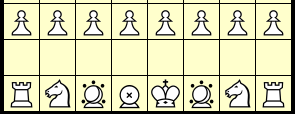[ List Earliest Comments Only For Pages | Games | Rated Pages | Rated Games | Subjects of Discussion ]
Comments by dotancohen
> It is not explicitly stated in the description: I assume, the game
> ends when the King is checkmated on the top board, i.e., a King
> cannot be "buried"?
Correct, we end the game when the King is checkmated on the top board. I will add that information to the description, thank you!
> ends when the King is checkmated on the top board, i.e., a King
> cannot be "buried"?
Correct, we end the game when the King is checkmated on the top board. I will add that information to the description, thank you!
> (a) Does moving onto a square where an opponent has your piece
> buried capture your own piece or the opponent's?, and in the
> former case what would be the advantage of making such a move in
> the first place?
Moving onto a square where an opponent has your piece buried: the opponent's piece is buried, and your buried piece is forever captured. The opponent's piece is now buried in the place where your own piece was buried. Thus, there becomes a strategy _not_ to defend your pieces, lest they be lost for good!
> (b)When a piece on the bottom board moves, must it capture another
> buried piece or does it capture a piece on the top board and thereby
> resurface (or may it do either)?
When a piece is on the bottom board, it can either stay where it is and then resurface there, or it can capture another buried piece and resurface in that new position. When capturing another buried piece, all pieces retain their normal moves and may only make moves that are captures. Id est, a bottom-board piece may _not_ move to an empty position.
> buried capture your own piece or the opponent's?, and in the
> former case what would be the advantage of making such a move in
> the first place?
Moving onto a square where an opponent has your piece buried: the opponent's piece is buried, and your buried piece is forever captured. The opponent's piece is now buried in the place where your own piece was buried. Thus, there becomes a strategy _not_ to defend your pieces, lest they be lost for good!
> (b)When a piece on the bottom board moves, must it capture another
> buried piece or does it capture a piece on the top board and thereby
> resurface (or may it do either)?
When a piece is on the bottom board, it can either stay where it is and then resurface there, or it can capture another buried piece and resurface in that new position. When capturing another buried piece, all pieces retain their normal moves and may only make moves that are captures. Id est, a bottom-board piece may _not_ move to an empty position.
3 comments displayed
Permalink to the exact comments currently displayed.
